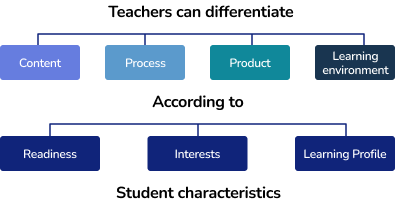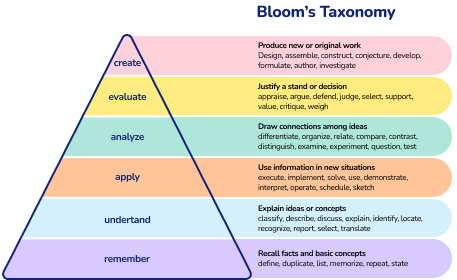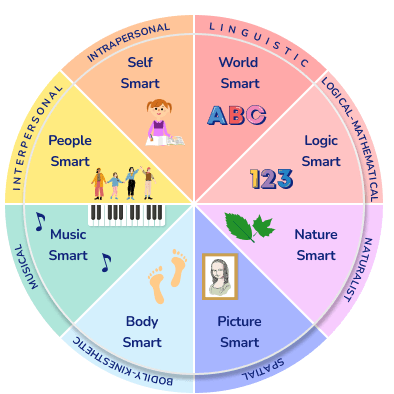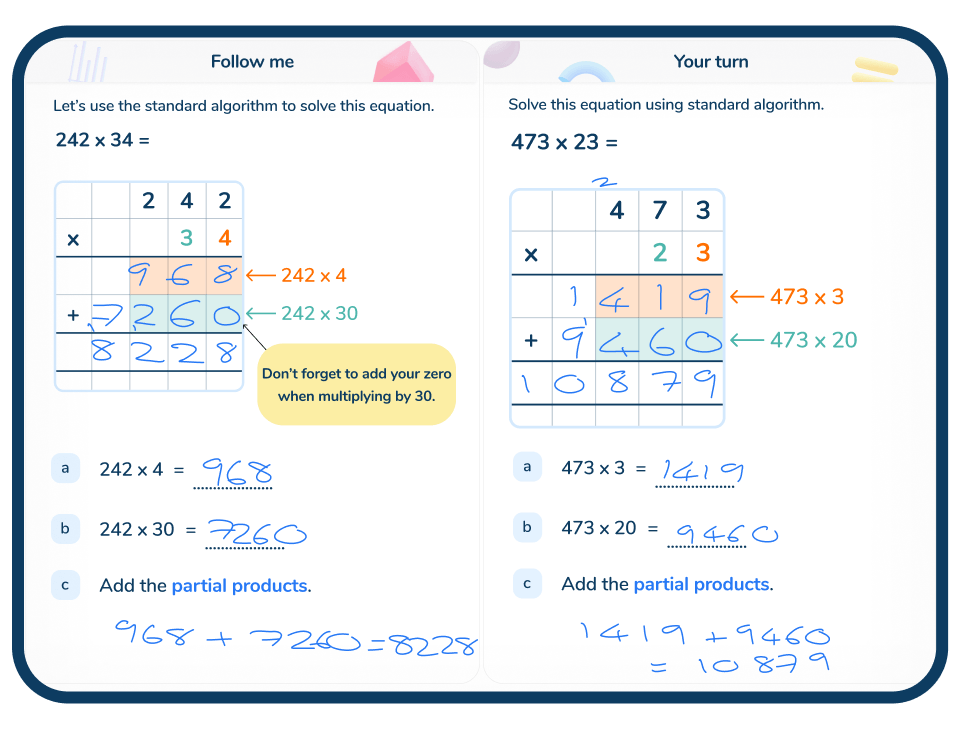Differentiated Instruction: 9 Differentiated Curriculum And Instruction Strategies For Teachers
Differentiated instruction helps teachers meet the needs of each student. Tailoring and differentiation instruction helps to provide lessons and activities that align with student’s knowledge, interests, and skills.
But in a classroom with 20 or more students, it is unlikely that every student will have the same skills, interests, or preferences.
This article explores in-depth what differentiated instruction is, its benefits and challenges plus 9 strategies to help you implement differentiated curriculum and instruction in your classroom today.
What is differentiated instruction?
Differentiated instruction means tailoring instruction to meet individual needs. It involves using a range of teaching strategies that provide students with instruction and tasks appropriate to their working level.
When teachers differentiate work, they prepare information, modeling, and tasks for each student, individually or in groups, according to their ability.
In terms of Vygotsky’s zones of proximal development, this means that each student is working right where they are ready to learn, not too high and not too low.
Researcher and professor at the University of Virginia, Carol Ann Tomlinson, describes differentiated instruction as how teachers take students’ levels of readiness and learning styles into account while they plan and deliver instruction. This means that teachers:
- Design lessons based on student preferences
- Group students by shared abilities or interests
- Use formative assessment to continually adjust instruction
Math Intervention Packs
Use these Number and Operation in Base Ten intervention packs with small groups or individuals who need differentiated instruction
Download Free Now!How can teachers differentiate instruction?
Carol Ann Tomlinson identified four strategies to implement differentiated instruction within the classroom:
- Content
- Process
- Product
- Learning environment

1. Content
Teachers can differentiate content according to student readiness, or when students have different levels of knowledge or understanding about a topic.
For example, some students may be familiar with how to calculate area and perimeter, while others have never been taught the skill. To accommodate student readiness, the teacher will differentiate the instruction and content of the lesson.
This does not mean teaching every student something different. It means acknowledging what students know and can do with a topic, and providing different mini-lessons and tasks so that each student is challenged.
Teachers can use Bloom’s Taxonomy to plan activities that reach students at their level. A teacher may provide explicit instruction to students who have not learned how to calculate area and perimeter, while students familiar with the concept apply that skill to designing a house floor plan.

2. Process
All students have preferences for how they learn best. Some enjoy listening to lectures, while others are more visual learners and some engage most in discussion. Differentiated instruction means providing various student centered learning and instruction strategies to help all students access and learn new information.
3. Product
Students also have preferences for showing they have mastered content. Some may prefer to draw, create models, or write. Teachers can differentiate tasks for students so they can demonstrate their understanding in a way suited to their preferences.
For example, a student may draw the process they used to complete a word problem while another may explain their answer in a paragraph. Both strategies can convey whether or not a student has mastered the content.
4. Learning environment
Creating student groups is an important part of differentiating — it can help with classroom management.
Classroom seating should be open and flexible to accommodate small groups, individual students, and the whole class across the day. One small group of students may need tailoring instruction for math and another group for science. Flexible seating allows students to move based on their needs. This also helps teachers manage the differentiated classroom in a controlled manner with similar ability students grouped closely for instruction.
Of course, mixed-ability classrooms can also accommodate differentiated instruction. Teachers may create a seating plan where students can benefit from other students’ strengths in certain subjects.
Differentiated classrooms should be diverse classrooms and include spaces that are quiet for students to work without distraction or causing cognitive overload.
Read more: Metacognition in the Classroom.
How to differentiate instruction for individual students?
Differentiation addresses student needs. According to Tomlinson, this is driven by a teacher’s knowledge of students’ readiness, interest, and learning profile.
Readiness
A student’s readiness to learn a skill is not the same as their ability. Everyone is a beginner at some point and students differ in their readiness levels.
The goal of differentiating for readiness is to provide students with the right amount of challenge so that they feel they are stretched, but not that the work is so difficult they are overwhelmed.
Interest
Students’ interests naturally engage them. When students are working on tasks that interest them, they are naturally motivated.
Teachers should not ask themselves “How do I motivate students?” but “What interests students? And how can I use that to engage them?”
When teachers are aware of student interests they can design lessons and activities that help students connect their interests to new learning. For example, if a student is interested in baking, design a measurement lesson around baking.
Learning profile
A student’s learning profile comes from a variety of factors, including:
- Culture: how students perceive time or what they focus on in a classroom
- Preference: how they work, set up their workspace, the environment
- Intelligence preference: how they prefer to learn
According to Gardner people have multiple intelligences broken down into 8 categories:
- Verbal-linguistic
- Logical-mathematical
- Bodily-kinesthetic
- Musical-rhythmic
- Spatial
- Naturalist
- Interpersonal
- Intrapersonal
Every student will have strengths in different intelligences.

Planning should be proactive, not reactive. Teachers learn about students and ask questions that will help them plan activities to meet students where they are, rather than planning a whole group activity and then tailoring parts of it to meet student needs.
Teachers should consider:
- Grouping
Plan for flexible grouping with a focus on creating groups that allow each student to learn best. Research supports using smaller groupings to address student needs. - Materials
Varying materials could mean providing each group with completely different materials. For example, one group may need manipulatives to demonstrate equal groups while another may use pencils and grid paper to solve multiplication problems. It could mean providing math problems according to reading levels. - Pacing
Pacing expectations should not be the same for all groups. Not all students learn or complete work at the same pace, or end at the same level. - Knowledge
Use student assessment to identify misconceptions and gaps in knowledge to help you design lessons that advance students to the next level. Ongoing types of assessment such as exit tickets can be beneficial when planning differentiated instruction.
Third Space Learning provides one-on-one personalized math tutoring for students who need differentiated instruction.
Highly trained math specialist tutors use ongoing assessments to identify and focus on the topics students need help with most.
Because lessons are one-on-one, students receive individualized instruction to help accelerate math progress and achievement at a faster rate than they would with group instruction.

How is differentiated instruction different from special education?
All students benefit from differentiated instruction. But students in special education may require specific accommodations or modifications to learn due to individual needs or a disability.
For example, a student who has dyslexia may be ready to learn how to compare decimals, but they may require the use of a slant board and text that is blocked to include just the relevant text. Or they may require the teacher to read the text to them as they work through each problem.
These accommodations are one way that students with disabilities receive additional differentiated instruction.
Benefits of differentiated instruction
High-quality differentiated instruction provides enormous benefits to students’ education. Here are some of the ways it can accelerate student achievement:
It works with all students
Planning instruction so that student’s learning needs are met, allows all students to make progress within learning objectives and keep pace with grade-level curriculum.
Helps students learn how to learn
When students are given multiple strategies for learning, they learn how they work best and engage in learning. They may, for example, figure out how to take notes in a way that works for them.
Increases student engagement
Curriculum content and instruction will engage students when it is delivered at the appropriate level. It means they can access the learning independently and as a result, reduces behavor problems in class.
Connects teachers and students
Creating a differentiated classroom requires teachers to learn about their students. In turn, this builds rapport and relationships, improving the classroom culture.
Drawbacks of differentiated instruction
While the benefits of differentiated instruction accelerate student progress, there are some drawbacks for school staff.
Requires additional work
Differentiation requires work at the beginning to identify what students know, and plan experiences that meet the needs of all learners.
In a class of 20 or more, each student may have differing needs and require work to be differentiated uniquely. This can add hours to teachers’ lesson planning time.
One way to overcome this extra workload is collaborative lesson planning. Team up with the same subject or same grade-level teachers to plan together and differentiate based on your students.
May be difficult to do in small spaces
At times, differentiation requires space to move and possibly rearrange furniture. A smaller classroom may not be conducive to changing groupings frequently.
Sometimes, it’s easier to take small groups out of the classroom for differentiated instruction — this is not always available in smaller school settings.
Still needs to be researched
While there is research out there, additional research is needed to determine the best and most efficient ways to differentiate instruction.
9 strategies for delivering differentiated instruction
There is no one-size-fits-all when it comes to differentiation. Teachers will be best placed to understand the strategies that work for their students. But here are 9 tried and tested differentiation strategies to use in the classroom that work:
1. Tiered assignments
Tiered assignments are designed to teach the same skill but will have different outcomes based on a student’s starting point.
For example, some students work with manipulatives to represent number amounts while others are given a number and challenged to represent it in different ways.
2. Flexible grouping
Set up groups for students to move through that allow them to learn the new concept, apply previously learned concepts, and revisit not mastered skills.
Groups can be set for some parts of the lesson, and mixed-ability for other parts.
3. Interest centers
Provide centers for students with different activities that reinforce the same skill.
For example, when exploring shapes, a teacher can provide a tangram center, a measurement center, and a video center. Students choose how they move through the centers.
4. Compacting
For students who have already mastered what is taught in class, compacting involves creating a plan for what each student needs to learn.
Excusing students from studying known material and allowing them to spend time practicing an accelerated skill.
5. Learning contracts
Develop a contract with the student that lays out the expectation for how a student will demonstrate mastery of a skill. Students write the ways they would prefer to complete the assignment.
Contracts allow students to work at their own pace and practice independence and responsibility.
6. Portfolios
Portfolios of work demonstrating what students can do are a way to differentiate student assessments.
Students compile collections of work showing what they have learned, rather than completing a standard assessment.
7. Mini-lessons
Instead of teaching the whole class, teach mini-lessons to small groups of students who need to master the skill.
Split starts can be useful here. Students who know what they are doing can carry on with tasks from a previous lesson while teachers instruct smaller groups.
Once they grasp the concept and begin independent work, the teacher can loop back the group that started with independent activity and provide instruction to accelerate learning.
8. Question and answer desk
While students work, sit at a question and answer desk where students can ask questions about content.
Prompt specific students to ask questions if you know they need support. This can be a useful tool for formative assessment.
9. Choice boards
Students choose from a list or board of options for how they learn about something. For example, students have the choice to learn about fractions by playing a game with a peer, watching a video, reading the textbook, or working through problems.
A choice board provides options for presenting student learning, including writing, modeling, drawing, creating a video, and more.
Making differentiated instruction work
Learning is individual for every student, teachers need to plan lessons that aren’t one-size-fits-all.
Consider what students already know and incorporate variety around content, procedure, process, and learning environment to create a differentiated classroom where all students can thrive.
Read more:
Differentiated instruction FAQs
The four aspects as outlined by researcher Carol Ann Tomlinson are content, process, product, and learning environment.
In a lesson plan, teaching methods, and assessments are adjusted to meet the needs of students. Lesson plans may have space to provide flexible grouping of students based on factors like student level or interest. The plan may incorporate differentiated instruction strategies for English language learners, gifted students, students who are receiving RTI intervention or those with disabilities.
Differentiating is not homogeneous grouping or teaching all students the same content at the same time. It is also not “streamlining” classes or “leveling classes.” Within the classroom, it is not giving students who have mastered content more free time, no homework, or having them teach students who need additional support.
One idea that teachers have incorporated into differentiation is the idea of learning styles or the idea that every child has a preferred way to learn (for example, that there are kinesthetic learners, auditory learners, etc). This idea has not been supported through research, though it is a popular idea in education.
Universal Design for Learning (UDL) is a way to plan learning experiences so all students can be successful. It is similar to differentiated instruction in that both focus on all students being able to access learning and succeed in the education environment. And, both are built on the idea that the environment should change to fit the learner, not the other way around. However, the core focus of UDL is that learning goals are the same for all students, and students are provided with different ways to reach those goals through multiple means of representation, expression, and engagement.





